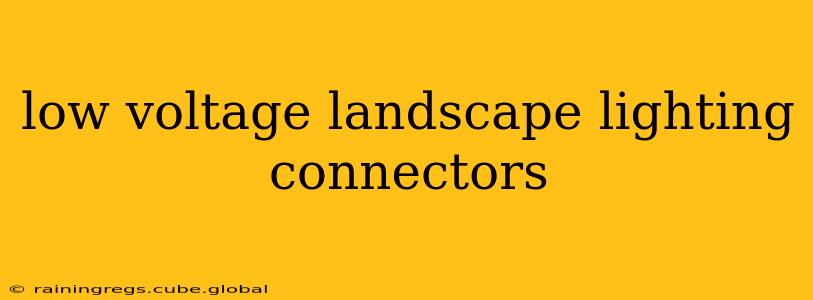Low voltage landscape lighting offers a beautiful and energy-efficient way to illuminate your outdoor spaces. However, properly connecting your lights is crucial for safety and optimal performance. This guide explores the various types of low voltage landscape lighting connectors, their applications, and how to choose the right ones for your project.
What Types of Low Voltage Landscape Lighting Connectors Are There?
Several connector types are used in low voltage landscape lighting systems. The most common include:
-
Wire Connectors: These are simple, inexpensive connectors that use wire nuts or crimp connectors to join wires together. They are suitable for permanent installations where access for repairs or replacements might be limited. Ensure you use connectors rated for the appropriate gauge of wire and outdoor use.
-
Push-in Connectors: These connectors allow for quick and easy connections without the need for tools. Simply push the wires into the designated slots. While convenient, they may not be as reliable as other types, particularly in harsh weather conditions. Check for proper connection after installation.
-
Quick Disconnects: These connectors offer easy disconnection and reconnection, ideal for seasonal installations or for easily accessing specific sections of the lighting system for maintenance or troubleshooting. They're often used with modular lighting systems.
-
Splice Connectors: These connectors are designed to join two wires without stripping the insulation. They are often used for joining wires that are difficult to access. While convenient, they must be properly sealed to prevent moisture intrusion.
-
Waterproof Connectors: Essential for outdoor use, these connectors feature weatherproof seals to protect the connections from moisture and corrosion. This is crucial for the longevity and safety of your landscape lighting.
What is the Best Connector for Low Voltage Landscape Lighting?
The "best" connector depends on several factors:
-
Your Skill Level: Push-in connectors are the easiest to use, while wire connectors require slightly more technical skill.
-
Permanence of Installation: Quick disconnects are ideal for temporary or easily accessible installations, whereas wire connectors are suitable for permanent, hard-to-reach areas.
-
Environmental Conditions: Waterproof connectors are essential for outdoor use, especially in areas with high humidity or precipitation.
For most DIY projects, waterproof push-in connectors offer a good balance of ease of use and reliability. However, for permanent installations or in extreme climates, high-quality waterproof wire connectors are recommended for their superior reliability and durability.
How Do I Connect Low Voltage Landscape Lighting?
Connecting low voltage landscape lighting typically involves these steps:
- Plan your layout: Map out the placement of your lights and plan your wiring routes.
- Choose the right connectors: Select connectors appropriate for your needs, considering factors mentioned above.
- Prepare the wires: Strip the insulation from the ends of the wires according to the connector instructions.
- Make the connections: Securely connect the wires using your chosen connectors.
- Test the connections: Before burying or concealing the wires, test the connections to ensure proper functionality.
- Seal and protect the connections: Use waterproof sealant or protective tape if necessary, especially for wire connectors.
Remember to always follow the manufacturer's instructions for your specific lighting system and connectors.
What Gauge Wire Should I Use with Low Voltage Landscape Lighting Connectors?
The appropriate wire gauge depends on the length of the run and the wattage of your lights. Consult the manufacturer's specifications for your lighting system. Using the wrong gauge wire can lead to voltage drop, resulting in dim lights or even system failure. Thicker gauge wire (lower number, e.g., 12 AWG) is better for longer runs.
Are Low Voltage Landscape Lighting Connectors Easy to Install?
The ease of installation varies depending on the connector type. Push-in connectors are generally the easiest, while wire connectors require some basic electrical skills. Regardless of the type, careful attention to detail is essential for a safe and functioning system.
Can I Use Standard Electrical Connectors for Low Voltage Landscape Lighting?
No, standard electrical connectors are not suitable for low voltage landscape lighting. Low voltage systems operate at significantly lower voltages than standard household electricity, and using incorrect connectors can lead to safety hazards and system malfunction. Always use connectors specifically designed for low voltage applications.
By understanding the different types of low voltage landscape lighting connectors and choosing the right ones for your project, you can ensure a safe, efficient, and beautiful outdoor lighting system. Remember to always prioritize safety and follow manufacturer instructions.
